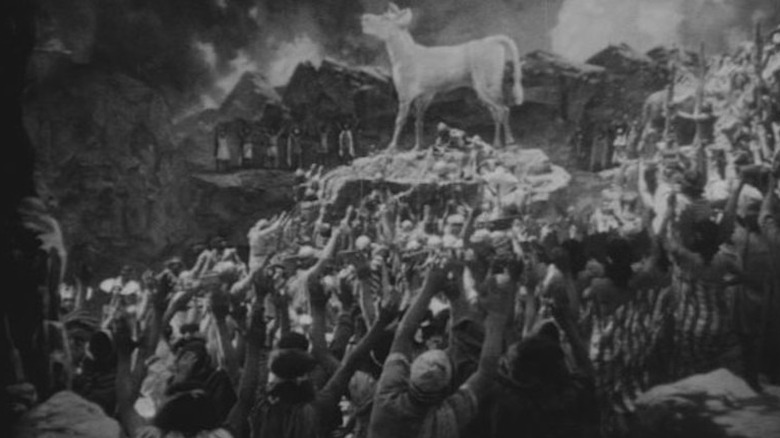The 1928 Bible Film That Allegedly Killed 3 People And Injured Countless Others
The topic of safety on film sets became a hot topic once again in the days following Halyna Hutchins' death on October 21, 2021, on the set of the Alec Baldwin film "Rust." The Ukrainian-born cinematographer was killed when Baldwin discharged a prop gun that, unbeknownst to the actor, contained a live projectile, and that immediately brought back tragic memories of Brandon Lee's death on the set of "The Crow" more than 25 years earlier. However, there have been several other accidental deaths that took place on the set of Hollywood productions, including a few that purportedly happened over 90 years ago during the shooting of a major disaster movie.
To be more specific, the movie in question was a biblical film from 1928, and as you'd probably expect from such projects, a lot had to be done in order for the flick to be as faithful as possible to what was written on the pages of the Good Book. Assuming what was claimed about the film's production is true, that authenticity tragically came at the cost of human life and also resulted in several others getting injured in the process.
Three people allegedly died during the flood scene in Noah's Ark
Back in 1928, more than a decade before he became best known as the director of films like "Casablanca," Michael Curtiz was a largely unknown director outside his birth country of Hungary, and it had been just two years since he moved to the U.S. and caught the attention of American filmmakers thanks to his reputation back home (via Britannica). 1928's "Noah's Ark" was one of Curtiz's first stateside projects, and it was a part-sound film in an era where silent movies were still the norm, juxtaposing the tale of Noah from the Book of Genesis with a romantic storyline set during World War I.
According to the book "The Movie Doctors," Curtiz's project was hyped up with the hyperbole so common for films of the era — supposedly, it was the "spectacle of the ages." As such, he wanted the scene depicting the Great Flood to be as authentic as possible. This, as claimed, entailed using 600,000 gallons of water to simulate the catastrophic biblical event that killed every living creature that wasn't on Noah's titular ark. Unfortunately, the scene reportedly resulted in the deaths of three extras, with many others suffering injuries — one extra purportedly had to have their leg amputated. (On an interesting note, John Wayne was among the extras, and it appears he escaped unscathed.)
Per WhatCulture, Curtiz's desire for a realistic flood scene was such that he repeatedly disregarded requests to use miniatures in lieu of real people and animals. This didn't sit well with cameraman Hal Mohr, who tried to convince Curtiz that it wouldn't be a good idea to put all those unsuspecting extras in grave danger. Mohr then quit the production after the director allegedly brushed off his concerns.
The Noah's Ark debacle led to safety reforms on Hollywood sets
Close to a century after "Noah's Ark" was made, the story of the three fatalities and the many extras who were injured during the flood sequences has yet to be completely corroborated — in fact, "The Movie Doctors" referred to it as "popular folklore." However, there's no disputing that simulating an epic flood in such a way was extremely dangerous to the men and women who had volunteered to appear as extras in the film. "Noah's Ark" is also credited for the introduction of safety regulations on Hollywood film sets that were imposed to make conditions less risky for actors, especially stunt performers.
On the other hand, those early reforms didn't do much to promote a safer working environment, as it was only in the 1980s when film codes were "significantly" updated to reduce such risks, according to The Guardian. It took the deaths of two young children, as well as veteran actor Vic Morrow, on the set of the 1983 film "Twilight Zone: The Movie" for Hollywood to take some serious action to that end. But even then, the lessons supposedly learned from "Noah's Ark" and "Twilight Zone: The Movie" were seemingly forgotten multiple times in the decades that followed, as evidenced by the many accidental on-set deaths since those films came out.


